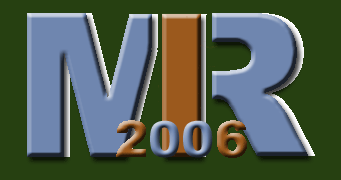Special Sessions
The MIR workshop this year will include two special sessions. They were selected from submitted session proposals based on the Call for Special Sessions.
Special Session 1: Query systems for data retrieval in large personal image and video databases
Organizers: Carole Dulong, Igor Kozintsev, Yi Wu, Intel, USA
Session Chair: Igor Kozintsev, Intel, USA
The emergence of ubiquitous communications, coupled with the shrinking cost and size of processing and storage units as well as the ever-increasing performance and/or capabilities of those units, have given rise to explosion of personal digital multimedia creation. As the rate of personal digital media creation rises, the demand for solutions to manage personal multimedia collections is increasing tremendously. Several recent important advances in the areas of computer vision, signal processing and machine learning open up new possibilities for creating such solutions.
Yet the challenges are many. To this moment, existing personal image and video management systems mostly rely on keywords in a form of user annotation and various metadata for searching. A few content based retrieval systems developed so far target mostly large stock photo collections, have very limited provisions for personalization and support only basic retrieval concepts. In contrast to that, personal media database management needs to deal with much more complex, mostly person-oriented concepts and lack of extensive annotation. This raises complexity of algorithms at all levels: vision and low-level feature extraction, ranking and classification, multimodal fusion, long-term and short-term on-line learning and user interface design.
This special session aims to provide a forum for the state-of-the-art research results in this emerging field and to address the growing interests both from academia and industry in mining and retrieval of multimedia data. The special session will focus on query mechanisms capable of supporting image and video retrieval in large personal databases. We propose to address algorithms for region-based query systems with semantics localization, efficient queries by example, query by concepts, aspects of the on-line learning of user queries, propagation of semantic concepts and the related problems. Among others, the questions we will try to address include the following: How do users manage search and interact with over 10K images in a personal database? How to interact, summarize, search tens of hours of home videos?
We have identified several key research groups and top experts, covering a wide range of topics under the special session theme, to present their latest work and findings. The presentations in the special session are as follows:
Lyndon Kennedy and Shih-Fu Chang, Columbia University, USA
G. Ciocca and R. Schettini,
DISCo (Dipartimento di Informatica, Sistemistica e Comunicazione)
Universit` degli Studi di Milano-Bicocca, Italy
Changhu Wang,
Department of EEIS, University of Science and Technology of China, China
Feng Jing, Lei Zhang, Hong-Jiang Zhang, Microsoft Research Asia, China
Qin Lv, William Josephson, Zhe Wang, Moses Charikar and Kai Li,
Princeton University, USA
Yan SONG, Meng WANG,Li-Rong DAI, Ren-Hua Wang,
Department of EEIS, University of Sci&Tech of China, China
Xian-Sheng HUA, Hong-Jiang ZHANG
Microsoft Research Asia, China
Special Session 2: Benchmarking Image and Video Retrieval
Organizers:
Stephane Marchand-Maillet, University of Geneva, Switzerland
Marcel Worring, University of Amsterdam, The Netherlands
Session Chair: Marcel Worring, University of Amsterdam, The Netherlands
The ease with which image and video can be captured has lead to a proliferation of image and video collections in all parts of society. Getting content based access to such collections is a difficult task. As a consequence, content based image and video retrieval has become a very active field of research building upon and extending techniques from computer vision, pattern recognition, human computer interaction, information retrieval and database management. Evaluating performance in such a complex and diverse field is difficult. How can you compare the performance of your method for image retrieval with your fellow researcher who is using similar algorithms on different datasets or your video retrieval method on the same video, but with different shots detected? Whats the value of the method that you recently read in a scientific paper? Is it worth to pursue for your own system? Why this technique shows such a limitation?
To answer these questions, we have seen the emergence of several image and video retrieval benchmarks. These benchmarks use fixed datasets with well defined units of retrieval and explicit tasks to solve. They allow objective comparison of different methods in a common framework. In addition, they allow objective measures to follow the progress made over the years. For image retrieval various benchmarks have been developed, each with their own merits. Creating a benchmark requires accepted well-defined purposes and sufficient commonalities between proposed systems. For image retrieval, it turns out that not only a common dialog between actors in the field is difficult to find, but also the interpretation of what a good image retrieval system should do varies. In video retrieval the TRECVID benchmark has become the de-facto standard. Currently for a topic like shot segmentation algorithms are not considered eligible for publication in a serious conference if they are not evaluated within the TRECVID benchmark. Other tasks like high-level feature extraction are likely to follow in the coming years.
This special session will consider many different aspects of benchmarking image and video retrieval. The data sources range from pure visual information, to visual information with associated free text, and finally to visual information and associated structured XML data. The evaluation methods consider both task as well as user criteria. The session will provide insight in the possibilities and the limitations of the various evaluation campaigns.
We have identified several key research groups and top experts to present their latest work and findings. The presentations in the special session are as follows:
Stephane Marchand-Maillet, University of Geneva, Switzerland
Marcel Worring, University of Amsterdam, The Netherlands
Christian Fluhr, Pierre-Alain Moellic, Patrick Hede, CEA-LIST, France.
Gary Marchionini, University of North Carolina, USA
Thijs Westerveld, CWI, The Netherlands
Roelof van Zwol, University of Utrecht, The Netherlands
Alan Smeaton, Dublin City University, Ireland
Paul Over, NIST, USA
Wessel Kraaij, TNO, The Netherlands.
Special Sessions Chair:
Nicu Sebe
University of Amsterdam
(Office) +31-20-5257552
(Fax) +31-20-5257490
(email) nicu AT science.uva.nl
(Web) http://www.science.uva.nl/~nicu

